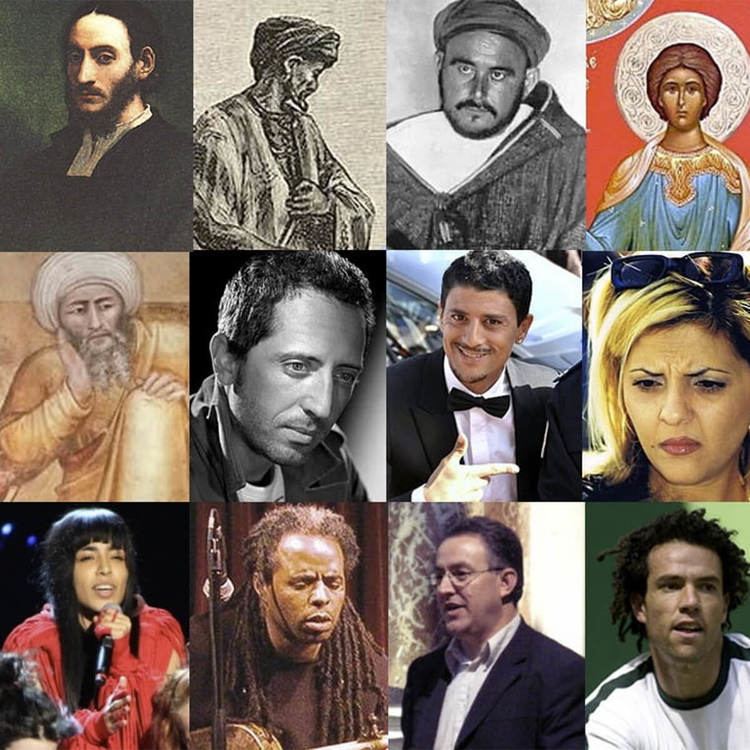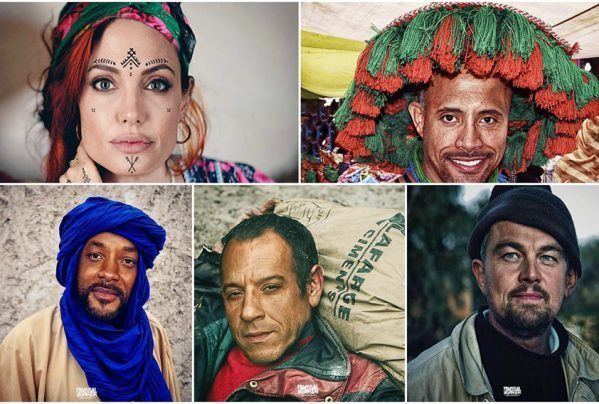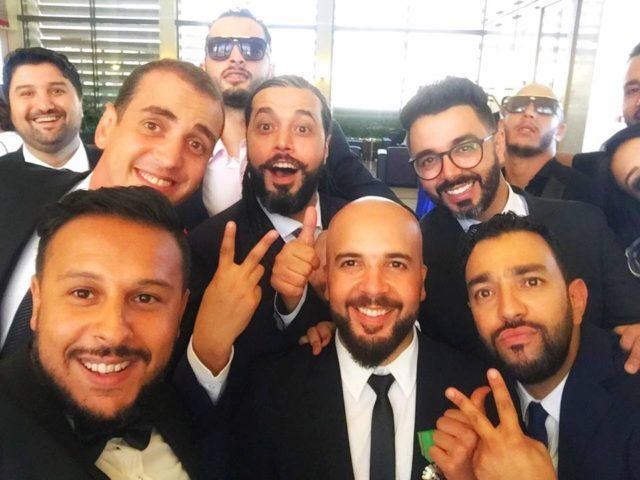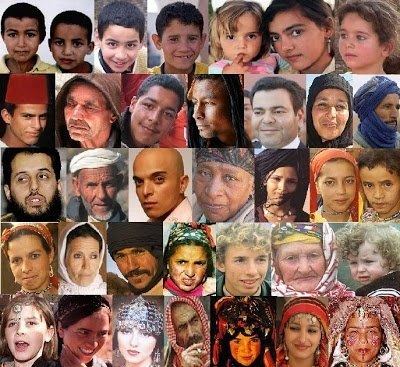Morocco 33,322,699 Spain 792,158 Belgium 500,000 | France 1,514,000 Italy 524,775 Israel 486,600 | |
 | ||
Moroccans try sushi for the first time
Moroccans (Arabic: المغاربة al-Magharibah, Berber: ⵉⵎⵖⵕⴰⴱⵉⵢⵏ ; Imɣṛabiyen) are a people that share a common Moroccan culture and ancestry.
Contents
- Moroccans try sushi for the first time
- Vlog 11 what spanish people think about moroccans the smart potato
- Physical anthropology of Moroccans
- First settlers
- DNA of Arabs
- J1 L2222
- E1b1b1a M78
- E1b1b1a M78 V22
- E1b1b1a M78 V65
- E1b1b1b M81
- Historically
- Berber genetic identity
- Physical differences between Berbers and Arabs of Morocco
- Culture
- Languages
- References
In addition to the 33 million Moroccans in Morocco, there is a large Moroccan diaspora in France, Belgium, Israel, Italy, the Netherlands, Spain, and a smaller one in United Kingdom, United States, Canada, Arabian Peninsula and in other Arab states. A sizable part of the Moroccan diaspora is composed of Moroccan Jews.

Vlog 11 what spanish people think about moroccans the smart potato
Physical anthropology of Moroccans

In traditional physical anthropology, the indigenous Berbers of Morocco and elsewhere in the Maghreb are among the various Hamitic inhabitants of Africa, representing the westernmost branch. As such, the principal morphological element in the local population is the Mediterranean type (Atlanto-Mediterranean and Basic Mediterranean).
First settlers

The first anatomically modern humans (Homo sapiens sapiens) in North Africa are the makers of the Aterian, a Middle Stone Age (or Middle Palaeolithic) stone tool culture. The earliest Aterian lithic assemblages date to around 145,000 years ago, and were discovered at the site of Ifri n'Ammar in Morocco. This industry was followed by the Iberomaurusian culture, a backed bladelet industry found throughout the Maghreb. It was originally described in 1909 at the site of Abri Mouillah. Other names for this Cro-Magnon-associated culture include Mouillian and Oranian. The Epipaleolithic Iberomaurusian makers were centered in prehistoric sites, such as Taforalt and Mechta-Afalou. They were succeeded by the Capsians. The Capsian culture is often thought to have arrived in Africa from the Near East, although it is also suggested that the Iberomaurusians may have been the progenitors of the Capsians. Around 5000 BC, the populations of North Africa were primarily descended from the makers of the Iberomaurusian and Capsian cultures, with a more recent intrusion associated with the Neolithic revolution. The proto-Berber tribes evolved from these prehistoric communities during the Late Bronze to Early Iron Age.
DNA of Arabs
The Arab people in Morocco have dominantly unique genetics which primarily exist of haplogroup J1, J2 and E1b1b1a.
J1 (L222.2)

Arabs of Morocco are a 20% J (L222.2), an accounts for the majority of (L147.1) in Saudi Arabia, Sudan & a primary element in North Africa. Seems to be an exclusively Adnani marker.
E1b1b1a M78
The Arabs of Morocco have 76% of Haplogroup E1b1b1a M78. The M78 subgroup exists of a few different subgroups, of which M78α is present amongst Arabs at 39% and M78β is present at 31,5%. To the M78 major subclade belongs V22 and V65 as well, which will be explained in the next chapters.
E1b1b1a M78 (V22)
Arabs of Morocco are a 40% E1b1b (V22), another lineage to expand out of Egypt. Found in various ethnic groups with a peaking frequency in Sudan & Egypt.
E1b1b1a M78 (V65)
Arabs of Morocco are a 30% E1b1b (V65), a marker of the Ancient Libyan tribes, marker of medieval expansion into Morocco joining Banu Hilal tribes once they reached Libya.
E1b1b1b (M81)
Arabs of Morocco are a 30% E1b1b (M81), a Proto-Berber marker E1b1b1b1a1 (M107) A reduced Proto-Berber lineage in Mali.
Historically
Between the Nile and the Red Sea were living Arab tribes expelled from Arabia for their turbulence, Banu Hilal and Sulaym, whose presence was very painful for farmers in the Nile Valley because the Arabs often came to plunder.
According to Ibn Khaldun, whole tribes set off with women, children, ancestors, animals and camping equipment.
Berber genetic identity
Moroccans primarily descend from Berbers, Arabized Berbers and Haratin/Gnawa, like other neighboring Maghrebans. As such, Berbers are descendants of the prehistoric populations of Morocco via the Iberomaurusians and Capsians.
The Afroasiatic family may have originated in the Mesolithic period, perhaps in the context of the Capsian culture. By 5000 BC, the populations of Morocco were an amalgamation of Ibero-Maurisian and a minority of Capsian stock blended with a more recent intrusion associated with the Neolithic revolution. Out of these populations, the proto-Berber tribes formed during the late Paleolithic era.
Physical differences between Berbers and Arabs of Morocco
It is easier to tell a Berber from an Arab by dress and behavior than by external physical characteristics, but there are statistical differences, particularly between the tribal Arabs and the mountain Berbers.
The highest frequencies of L-mtDNA in Moroccan cities is reported for the Moroccan Arabs of the surrounding area of El Jadida at 46%. Harich et al 2010
Frequencies (> 1%) of L-mtDNA
Berber-speaking groups include the Riffians, Shilha and Zayanes. Arabic-speaking groups include the Jebala in the north and Sahrawiyin in the southeast.
A small minority of the population is identified as Haratin and Gnawa. These are sedentary agriculturalists of non-Berber origin, who inhabit the southern and eastern oases and speak either Berber or Moroccan Arabic.
Culture
Through Moroccan history, the country had many cultural influences (Europe, Middle East and sub-Saharan Africa). The culture of Morocco shares similar traits with those of neighboring countries, particularly Algeria and Tunisia and to a certain extent Spain.
Morocco influenced modern day Europe, in several fields, from architecture to agriculture, and the introduction of Moroccan numbers, widely used now in the world.
Each region possesses its own uniqueness, contributing to the national culture. Morocco has set among its top priorities the protection of its diversity and the preservation of its cultural heritage.
The traditional dress for men and women is called djellaba, a long, loose, hooded garment with full sleeves. For special occasions, men also wear a red cap called a bernousse, more commonly known as a fez. Women wear kaftans decorated with ornaments. Nearly all men, and most women, wear balgha (بلغه). These are soft leather slippers with no heel, often dyed yellow. Women also wear high-heeled sandals, often with silver or gold tinsel.
Moroccan style is a new trend in decoration, which takes its roots from Moorish architecture. It has been made popular by the vogue of riad renovation in Marrakech. Dar is the name given to one of the most common types of domestic structures in Morocco; it is a home found in a medina, or walled urban area of a city. Most Moroccan homes traditionally adhere to the Dar al-Islam, a series of tenets on Islamic domestic life. Dar exteriors are typically devoid of ornamentation and windows, except occasional small openings in secondary quarters, such as stairways and service areas. These piercings provide light and ventilation.
Moroccan cuisine primarily consists of a blend of Berber, Moorish and Arab influences. It is known for dishes like couscous and pastilla, among others. Spices such as cinnamon are also used in Moroccan cooking. Sweets like halwa are popular, as well as other confections. Cuisines from neighbouring areas have also influenced the country's culinary traditions.
Additionally, Moroccan craftsmanship has a rich tradition of jewellery-making, pottery, leather-work and woodwork.
The music of Morocco ranges and differs according to the various areas of the country. Moroccan music has a variety of styles from complex sophisticated orchestral music to simple music involving only voice and drums. There are three varieties of Berber folk music: village and ritual music, and the music performed by professional musicians. Chaabi (الشعبي) is a music consisting of numerous varieties which descend from the multifarious forms of Moroccan folk music. Chaabi was originally performed in markets, but is now found at any celebration or meeting. Gnawa is a form of music that is mystical. It was gradually brought to Morocco by the Gnawa and later became part of the Moroccan tradition. Sufi brotherhoods (tarikas) are common in Morocco, and music is an integral part of their spiritual tradition. This music is an attempt at reaching a trance state which inspires mystical ecstasy.
Languages
Morocco's official languages are Classical Arabic and Amazigh. The latter is a standardized version of the Berber languages.
The majority of the population speaks Moroccan Arabic. More than 12 million Moroccans speak Berber varieties, either as a first language or bilingually with Moroccan Arabic. Three different Berber dialects are spoken: Riff, Shilha (Chleuh) and Central Atlas Tamazight.
Hassaniya Arabic is spoken in the southern part of the country. Morocco has recently included the protection of Hassaniya in the constitution as part of the July 2011 reforms.
French is taught universally and still serves as Morocco's primary language of commerce and economics; it is also widely used in education, sciences, government and most education fields.
Spanish is also spoken by some in the northern part of the country as a foreign language. Meanwhile, English is increasingly becoming more popular among the educated, particularly in the science fields.
